
Entries tagged as hardware
Related tags
3d camera flash game headset history mobile mobile phone software technology tracking virtual reality web wiki www 3d printing 3d scanner crowd-sourcing diy evolution facial copy food innovation&society medecin microsoft physical computing piracy programming rapid prototyping recycling robot virus ad android ai algorythm apple arduino automation data mining data visualisation network neural network sensors siri amd cpu intel qualcomm app google htc ios linux os sdk super collider tablet usb api facial recognition glass interface mirror amazon cloud iphone ar augmented reality satellite army drone artificial intelligence big data car cloud computing privacy program super computer asus kinect light wifi chrome browser firefox ie laptop computing farm open source security sustainabilityTuesday, October 29. 2013
Surprisingly simple scheme for self-assembling robots
Via MIT
-----
Small cubes with no exterior moving parts can propel themselves forward, jump on top of each other, and snap together to form arbitrary shapes.
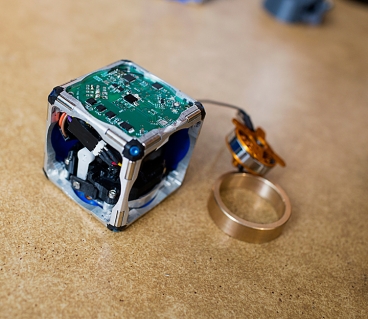
A prototype of a new modular robot,
with its innards exposed and its
flywheel — which gives it the ability to move independently — pulled
out.
Photo: M. Scott Brauer
In 2011, when an MIT senior named John Romanishin proposed a new design
for modular robots to his robotics professor, Daniela Rus, she said,
“That can’t be done.”
Two years later, Rus showed her colleague
Hod Lipson, a robotics researcher at Cornell University, a video of
prototype robots, based on Romanishin’s design, in action. “That can’t
be done,” Lipson said.
In November, Romanishin — now a research
scientist in MIT’s Computer Science and Artificial Intelligence
Laboratory (CSAIL) — Rus, and postdoc Kyle Gilpin will establish once
and for all that it can be done, when they present a paper describing
their new robots at the IEEE/RSJ International Conference on Intelligent
Robots and Systems.
Known as M-Blocks, the robots are cubes with
no external moving parts. Nonetheless, they’re able to climb over and
around one another, leap through the air, roll across the ground, and
even move while suspended upside down from metallic surfaces.
Inside
each M-Block is a flywheel that can reach speeds of 20,000 revolutions
per minute; when the flywheel is braked, it imparts its angular momentum
to the cube. On each edge of an M-Block, and on every face, are
cleverly arranged permanent magnets that allow any two cubes to attach
to each other.
“It’s one of these things that the
[modular-robotics] community has been trying to do for a long time,”
says Rus, a professor of electrical engineering and computer science and
director of CSAIL. “We just needed a creative insight and somebody who
was passionate enough to keep coming at it — despite being discouraged.”
Embodied abstraction
As Rus explains,
researchers studying reconfigurable robots have long used an abstraction
called the sliding-cube model. In this model, if two cubes are face to
face, one of them can slide up the side of the other and, without
changing orientation, slide across its top.
The sliding-cube
model simplifies the development of self-assembly algorithms, but the
robots that implement them tend to be much more complex devices. Rus’
group, for instance, previously developed a modular robot called the Molecule,
which consisted of two cubes connected by an angled bar and had 18
separate motors. “We were quite proud of it at the time,” Rus says.
According
to Gilpin, existing modular-robot systems are also “statically stable,”
meaning that “you can pause the motion at any point, and they’ll stay
where they are.” What enabled the MIT researchers to drastically
simplify their robots’ design was giving up on the principle of static
stability.
“There’s a point in time when the cube is essentially
flying through the air,” Gilpin says. “And you are depending on the
magnets to bring it into alignment when it lands. That’s something
that’s totally unique to this system.”
That’s also what made Rus
skeptical about Romanishin’s initial proposal. “I asked him build a
prototype,” Rus says. “Then I said, ‘OK, maybe I was wrong.’”
Sticking the landing
To
compensate for its static instability, the researchers’ robot relies on
some ingenious engineering. On each edge of a cube are two cylindrical
magnets, mounted like rolling pins. When two cubes approach each other,
the magnets naturally rotate, so that north poles align with south, and
vice versa. Any face of any cube can thus attach to any face of any
other.
The cubes’ edges are also beveled, so when two cubes are
face to face, there’s a slight gap between their magnets. When one cube
begins to flip on top of another, the bevels, and thus the magnets,
touch. The connection between the cubes becomes much stronger, anchoring
the pivot. On each face of a cube are four more pairs of smaller
magnets, arranged symmetrically, which help snap a moving cube into
place when it lands on top of another.
As with any modular-robot
system, the hope is that the modules can be miniaturized: the ultimate
aim of most such research is hordes of swarming microbots that can
self-assemble, like the “liquid steel” androids in the movie “Terminator
II.” And the simplicity of the cubes’ design makes miniaturization
promising.
But the researchers believe that a more refined
version of their system could prove useful even at something like its
current scale. Armies of mobile cubes could temporarily repair bridges
or buildings during emergencies, or raise and reconfigure scaffolding
for building projects. They could assemble into different types of
furniture or heavy equipment as needed. And they could swarm into
environments hostile or inaccessible to humans, diagnose problems, and
reorganize themselves to provide solutions.
Strength in diversity
The
researchers also imagine that among the mobile cubes could be
special-purpose cubes, containing cameras, or lights, or battery packs,
or other equipment, which the mobile cubes could transport. “In the vast
majority of other modular systems, an individual module cannot move on
its own,” Gilpin says. “If you drop one of these along the way, or
something goes wrong, it can rejoin the group, no problem.”
“It’s
one of those things that you kick yourself for not thinking of,”
Cornell’s Lipson says. “It’s a low-tech solution to a problem that
people have been trying to solve with extraordinarily high-tech
approaches.”
“What they did that was very interesting is they
showed several modes of locomotion,” Lipson adds. “Not just one cube
flipping around, but multiple cubes working together, multiple cubes
moving other cubes — a lot of other modes of motion that really open the
door to many, many applications, much beyond what people usually
consider when they talk about self-assembly. They rarely think about
parts dragging other parts — this kind of cooperative group behavior.”
In
ongoing work, the MIT researchers are building an army of 100 cubes,
each of which can move in any direction, and designing algorithms to
guide them. “We want hundreds of cubes, scattered randomly across the
floor, to be able to identify each other, coalesce, and autonomously
transform into a chair, or a ladder, or a desk, on demand,” Romanishin
says.
Monday, October 28. 2013
Cuttable, Foldable Sensors Can Add Multi-Touch To Any Device
Via TechCrunch
-----
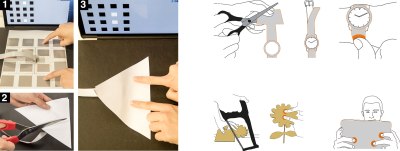
Researchers at the MIT Media Lab and the Max Planck Institutes have created a foldable, cuttable multi-touch sensor that works no matter how you cut it, allowing multi-touch input on nearly any surface.
In traditional sensors the connectors are laid out in a grid and when one part of the grid is damaged you lose sensitivity in a wide swathe of other sensors. This system lays the sensors out like a star which means that cut parts of the sensor only effect other parts down the line. For example, you cut the corners off of a square and still get the sensor to work or even cut all the way down to the main, central connector array and, as long as there are still sensors on the surface, it will pick up input.

The team that created it, Simon Olberding, Nan-Wei Gong, John Tiab, Joseph A. Paradiso, and Jürgen Steimle, write:
This very direct manipulation allows the end-user to easily make real-world objects and surfaces touch interactive,
to augment physical prototypes and to enhance paper craft. We contribute
a set of technical principles for the design of printable circuitry
that makes the sensor more robust against cuts, damages and removed
areas. This includes
novel physical topologies and printed forward error correction.
You can read the research paper here but this looks to be very useful in the DIY hacker space as well as for flexible, wearable projects that require some sort of multi-touch input. While I can’t imagine we need shirts made of this stuff, I could see a sleeve with lots of inputs or, say, a watch with a multi-touch band.
Don’t expect this to hit the next iWatch any time soon – it’s still very much in prototype stages but definitely looks quite cool.
Tuesday, October 15. 2013
Qualcomm Neural Processing Units to mimic human brains for your phone
Via SlashGear
-----
Qualcomm
is readying a new kind of artificial brain chip, dubbed neural
processing units (NPUs), modeling human cognition and opening the door
to phones, computers, and robots that could be taught in the same ways
that children learn. The first NPUs are likely to go into production by
2014, CTO Matt Grob confirmed at the MIT Technology Review
EmTech conference, with Qualcomm in talks with companies about using
the specialist chips for artificial vision, more efficient and
contextually-aware smartphones and tablets, and even potentially brain
implants.
According to Grob, the advantage of NPUs over traditional chips like
Qualcomm’s own Snapdragon range will be in how they can be programmed.
Instead of explicitly instructing the chips in how processing should
take place, developers would be able to teach the chips by example. “This ‘neuromorphic’ hardware
is biologically inspired – a completely different architecture – and
can solve a very different class of problems that conventional
architecture is not good at,” Grob explained of the NPUs. “It really
uses physical structures derived from real neurons – parallel and
distributed.” As a result, “this is a kind of machine that can learn, and be
programmed without software – be programmed the way you teach your kid”
Grob predicted. However it’s not only robots that can learn which will benefit
from the NPUs, Qualcomm says. “We want to make it easier for
researchers to make a part of the brain” Grob said, bringing abilities
like classification and prediction to a new generation of electronics. That might mean computers
that are better able to filter large quantities of data to suit the
particular needs of the user at any one time, smartphone assistants like
Google Now with supercharged contextual intuition, and autonomous cars
that can dynamically recognize and understand potential perils in the
road ahead. The first partnerships actually implementing NPUs in that way are
likely to come in 2014, Grob confirmed, with Qualcomm envisaging hugely
parallel arrays of the chips being put into practice to model how humans
might handle complex problems.
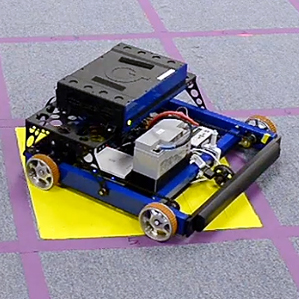 In fact, Qualcomm already has a learning machine in its labs that uses the same sort of biologically-inspired programming system
that the NPUs will enable. A simple wheeled robot, it’s capable of
rediscovering a goal location after being told just once that it’s
reached the right point.
In fact, Qualcomm already has a learning machine in its labs that uses the same sort of biologically-inspired programming system
that the NPUs will enable. A simple wheeled robot, it’s capable of
rediscovering a goal location after being told just once that it’s
reached the right point.
Monday, October 14. 2013
MIT's 'Kinect of the future' looks through walls with X-ray like vision
Via PCWorld
-----
Massachusetts Institute of Technology researchers have developed a device that can see through walls and pinpoint a person with incredible accuracy. They call it the “Kinect of the future,” after Microsoft’s Xbox 360 motion-sensing camera.
Shown publicly this week for the first time, the project from MIT’s Computer Science and Artificial Laboratory (CSAIL) used three radio antennas spaced about a meter apart and pointed at a wall.
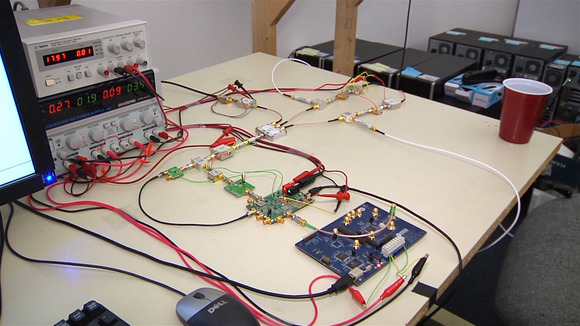 Photo: Nick Barber
Photo: Nick Barber
A desk cluttered with wires and circuits generated and interpreted the radio waves. On the other side of the wall, a person walked around the room and the system represented that person as a red dot on a computer screen. The system tracked the movements with an accuracy of plus or minus 10 centimeters, which is about the width of an adult hand.
Fadel Adib, a Ph.D student on the project, said that gaming could be one use for the technology, but that localization is also very important. He said that Wi-Fi localization, or determining someone’s position based on Wi-Fi, requires the user to hold a transmitter, like a smartphone for example.
“What we’re doing here is localization through a wall without requiring you to hold any transmitter or receiver [and] simply by using reflections off a human body,” he said. “What is impressive is that our accuracy is higher than even state of the art Wi-Fi localization.”
He said that he hopes further iterations of the project will offer a real-time silhouette rather than just a red dot.
In the room where users walked around there was white tape on the floor in a circular design. The tape on the floor was also in the virtual representation of the room on the computer screen. It wasn’t being used an aid to the technology, rather it showed onlookers just how accurate the system was. As testers walked on the floor design their actions were mirrored on the computer screen.
One of the drawbacks of the system is that it can only track one moving person at a time and the area around the project needs to be completely free of movement. That meant that when the group wanted to test the system they would need to leave the room with the transmitters as well as the surrounding area; only the person being tracked could be nearby.
At the CSAIL facility the researchers had the system set up between two offices, which shared an interior wall. In order to operate it, onlookers needed to stand about a meter or two outside of both of the offices as to not create interference for the system.
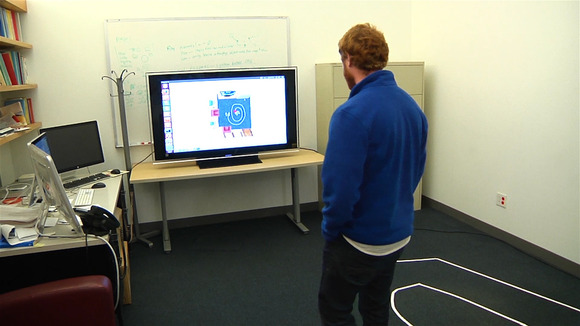 Photo: Nick Barber
Photo: Nick Barber
The system can only track one person at a time, but that doesn’t mean two people can’t be in the same room at once. As long as one person is relatively still the system will only track the person that is moving.
The group is working on making the system even more precise. “We now have an initial algorithm that can tell us if a person is just standing and breathing,” Adib said. He was also able to show how raising an arm could also be tracked using radio signals. The red dot would move just slightly to the side where the arm was raised.
Adib also said that unlike previous versions of the project that used Wi-Fi, the new system allows for 3D tracking and could be useful in telling when someone has fallen at home.
The system now is quite bulky. It takes up an entire desk that is strewn with wires and then there’s also the space used by the antennas.
“We can put a lot of work into miniaturizing the hardware,” said research Zach Kabelac, a masters student at MIT. He said that the antennas don’t need to be as far apart as they are now.
“We can actually bring these closer together to the size of a Kinect [sensor] or possibly smaller,” he said. That would mean that the system would “lose a little bit of accuracy,” but that it would be minimal.
The researchers filed a patent this week and while there are no immediate plans for commercialization the team members were speaking with representatives from major wireless and component companies during the CSAIL open house.
Wednesday, October 09. 2013
Intel outfits open-source Galileo DIY computer with new Quark chip
Via pcworld
-----
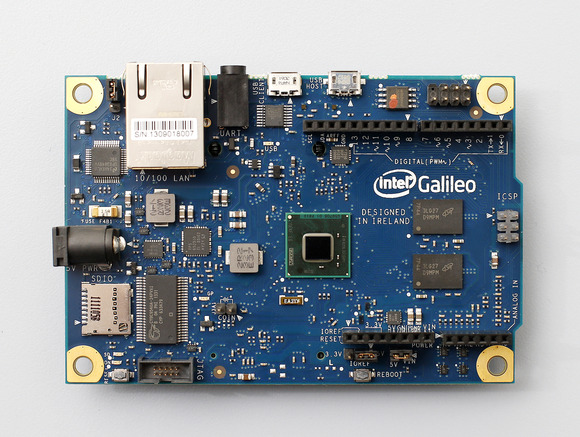
With its first computer based on the extremely low-power Quark processor, Intel is tapping into the 'maker' community to figure out ways the new chip could be best used.
The chip maker announced the Galileo computer -- which is a board without a case -- with the Intel Quark X1000 processor on Thursday. The board is targeted at the community of do-it-yourself enthusiasts who make computing devices ranging from robots and health monitors to home media centers and PCs.
The Galileo board should become widely available for under $60 by the end of November, said Mike Bell, vice president and general manager of the New Devices Group at Intel.
Bell hopes the maker community will use the board to build prototypes and debug devices. The Galileo board will be open-source, and the schematics will be released over time so it can be replicated by individuals and companies.
Bell's New Devices Group is investigating business opportunities in the emerging markets of wearable devices and the "Internet of things." The chip maker launched the extremely low-power Quark processor for such devices last month.
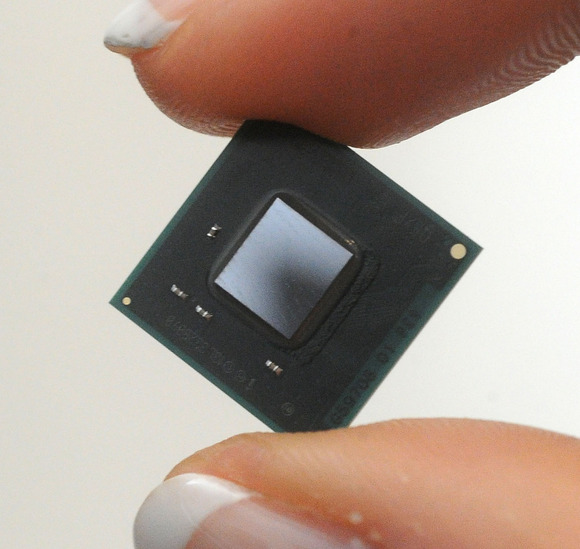
"People want to be able to use our chips to do creative things," Bell said. "All of the coolest devices are coming from the maker community."
But at around $60, the Galileo will be more expensive than the popular Raspberry Pi, which is based on an ARM processor and sells for $25. The Raspberry Pi can also render 1080p graphics, which Intel's Galileo can't match.
Making inroads in the enthusiast community
Questions also remain on whether Intel's overtures will be accepted by the maker community, which embraces the open-source ethos of a community working together to tweak hardware designs. Intel has made a lot of contributions to the Linux OS, but has kept its hardware designs secret. Intel's efforts to reach out to the enthusiast community is recent; the company's first open-source PC went on sale in July.
Intel is committed long-term to the enthusiast community, Bell said.
Intel also announced a partnership with Arduino, which provides a software development environment for the Galileo motherboard. The enthusiast community has largely relied on Arduino microcontrollers and boards with ARM processors to create interactive computing devices.
The Galileo is equipped with a 32-bit Quark SoC X1000 CPU, which has a clock speed of 400MHz and is based on the x86 Pentium Instruction Set Architecture. The Galileo board supports Linux OS and the Arduino development environment. It also supports standard data transfer and networking interfaces such as PCI-Express, Ethernet and USB 2.0.
Intel has demonstrated its Quark chip running in eyewear and a medical patch to check for vitals. The company has also talked about the possibility of using the chip in personalized medicine, sensor devices and cars.
Intel hopes creating interactive computing devices with Galileo will be easy. Writing applications for the board is as simple as writing programs to standard microcontrollers with support for the Arduino development environment.
"Essentially it's transparent to the development," Bell said.
Intel is shipping out 50,000 Galileo boards for free to students at over 1,000 universities over the next 18 months.
Friday, October 04. 2013
The First Carbon Nanotube Computer: The Hyper-Efficient Future Is Here
Via Gizmodo
-----

Coming just a year after the creation of the first carbon nanotube computer chip, scientists have just built the very first actual computer with a central processor centered entirely around carbon nanotubes. Which means the future of electronics just got tinier, more efficient, and a whole lot faster.
Built by a group of engineers at Stanford University, the computer itself is relatively basic compared to what we're used to today. In fact, according to Suhasish Mitra, an electrical engineer at Stanford and project co-leader, its capabilities are comparable to an Intel 4004—Intel's first microprocessor released in 1971. It can switch between basic tasks (like counting and organizing numbers) and send data back to an external memory, but that's pretty much it. Of course, the slowness is partially due to the fact the computer wasn't exactly built under the best conditions, MIT Technology Review explains:
"Don't let that fool you, though—this is just the first step. Last year, IBM proved that carbon nanotube transistors can run about three times as fast as the traditional silicon variety, and we'd already managed to arrange over 10,000 carbon nanotubes onto a single chip. They just hadn't connected them in a functioning circuit. But now that we have, the future is looking awfully bright."
Theoretically, carbon nanotube computing would be an order of magnitude faster that what we've seen thus far with any material. And since carbon nanotubes naturally dissipate heat at an incredible rate, computers made out of the stuff could hit blinding speeds without even breaking a sweat. So the speed limits we have using silicon—which doesn't do so well with heat—would be effectively obliterated.
The future of breakneck computing doesn't come without its little speedbumps, though. One of the problems with nanotubes is that they grow in a generally haphazard fashion, and some of them even come out with metallic properties, short-circuiting whatever transistor you decided to shove it in. In order to overcome these challenges, the researchers at Stanford had to use electricity to vaporize any metallic nanotubes that cropped up and formulated design algorithms that would be able to function regardless of any nanotube alignment problems. Now it's just a matter of scaling their lab-grown methods to an industrial level—easier said than done.
Still, despite the limitations at hand, this huge advancement just put another nail in silicon's ever-looming coffin.
Image: Norbert von der Groeben/Stanford
Wednesday, October 02. 2013
Scientists want to turn smartphones into earthquake sensors
Via The Verge
-----

For years, scientists have struggled to collect accurate real-time data on earthquakes, but a new article published today in the Bulletin of the Seismological Society of America may have found a better tool for the job, using the same accelerometers found in most modern smartphones. The article finds that the MEMS accelerometers in current smartphones are sensitive enough to detect earthquakes of magnitude five or higher when located near the epicenter. Because the devices are so widely used, scientists speculate future smartphone models could be used to create an "urban seismic network," transmitting real-time geological data to authorities whenever a quake takes place.
The authors pointed to Stanford's Quake-Catcher Network as an inspiration, which connects seismographic equipment to volunteer computers to create a similar network. But using smartphone accelerometers would be cheaper and easier to carry into extreme environments. The sensor will need to become more sensitive before it can be used in the field, but the authors say once technology catches up, a smartphone accelerometer could be the perfect earthquake research tool. As one researcher told The Verge, "right from the start, this technology seemed to have all the requirements for monitoring earthquakes — especially in extreme environments, like volcanoes or underwater sites."
Monday, September 30. 2013
The $400 Deltaprintr Is A Cheap Way To Make Really Big 3D Prints
Via TechCrunch
-----

Another day, another 3D printer. This time we have a model that comes from SUNY Purchase College where they are working on a laser-cut, compact 3D printer that can make extra tall models simply by swapping out a few pieces.
The printer pumps out plastic at 100 microns, a more than acceptable resolution, and uses very few moving parts. You’ll notice that the print head rides up three rails. This would allow you to add longer bars or extensions to bring things bigger than the platform.
Created by students Shai Schechter, Andrey Kovalev, Yasick Nemenov and Eugene Sokolov, the project is currently in pre-beta and they aim to launch a crowdfunding campaign in November. You can sign up for updates here.
The team hopes to make the product completely open source and because it uses very few expensive parts they’re able to price it very aggressively. While I love projects like these, I’m anxious to see how they build their software – one of the most important parts of a 3D printing package. As long as it’s solid I’d totally be down with this cool rig.
Monday, September 23. 2013
Qualcomm joins Wireless Power Consortium board, sparks hope for A4WP and Qi unification
Via endgadget
-----
Qualcomm, the founding member of Alliance for Wireless Power (or A4WP in short), made a surprise move today by joining the management board of the rival Wireless Power Consortium (or WPC), the group behind the already commercially available Qi standard. This is quite an interesting development considering how both alliances have been openly critical of each other, and yet now there's a chance of seeing just one standard getting the best of both worlds. That is, of course, dependent on Qualcomm's real intentions behind joining the WPC.
While Qi is now a well-established ecosystem backed by 172 companies, its current "first-gen" inductive charging method is somewhat sensitive to the alignment of the devices on the charging mats (though there has been recent breakthrough). Another issue is Qi can currently provide just up to 5W of power (which is dependent on both the quality of the coil and the operating frequency), and this may not be sufficient for charging up large devices at a reasonable pace. For instance, even with the 10W USB adapter, the iPad takes hours to fully juice up, let alone with just half of that power.
Looking ahead, both the WPC and the 63-strong A4WP are already working on their own magnetic resonance implementations to enable longer range charging. Additionally, A4WP's standard has also been approved for up to 24W of output, whereas the WPC is already developing medium power (from 15W) Qi specification for the likes of laptops and power tools.
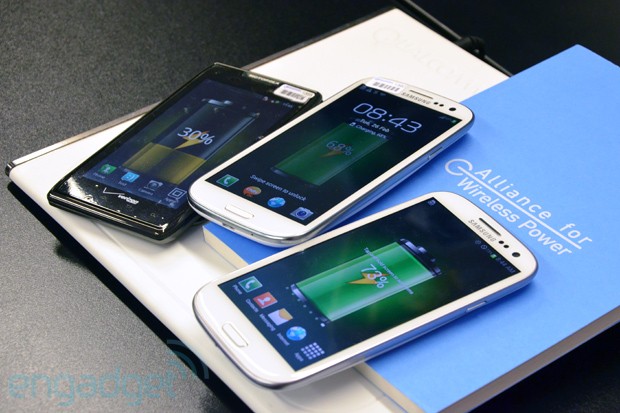
Here's where the two standards differentiate. A4WP's implementation allows simultaneous charging of devices that require different power requirement on the same pad, thus offering more spacial freedom. On the other hand, Qi follows a one-to-one control design to maximize efficiency -- as in the power transfer is totally dependent on how much juice the device needs, and it can even go completely off once the device is charged.
What remains unclear is whether Qualcomm has other motives behind its participation in the WPC's board of management. While the WPC folks "encourage competitors to join" for the sake of "open development of Qi," this could also hamper the development of their new standard. Late last year, we spoke to the WPC's co-chair Camille Tang (the name "Qi" was actually her idea; plus she's also the president and co-founder of Hong Kong-based Convenient Power), and she expressed concern over the potential disruption from the new wireless power groups.
"The question to ask is: why are all these groups now coming out and saying they're doing a standard? It's possible that some people might say they really are a standard, but they may actually not intend to put products out there," said Tang.
"For example, there's one company with their technology and one thing that's rolling out in infrastructure. They don't have any devices, it's not compatible with anything else, so you think: why do they do that?
"It's about money. Not just licensing money, but other types of money as well."
At least on the surface, Qualcomm is showing its keen side to get things going for everyone's best interest. In a statement we received from a spokesperson earlier, the company implied that joining the WPC's board is "the logical step to grow the wireless power industry beyond the current first generation products and towards next generation, loosely coupled technology." However, Qualcomm still "believes the A4WP represents the most mature and best implementation of resonant charging."
Saturday, September 21. 2013
Hackers are crowd-funding a bounty to hack the iPhone 5S fingerprint scanner
Via o.canada.com
-----

The 5S features a fingerprint sensor, has an upgraded camera, and contains an A7 chip Photo: Justin Sullivan/Getty Images
Hackers from around the world have put together more than $15,000 they hope will be enough to entice the smartest hackers to break into the new iPhone’s much-lauded fingerprint scanner.
The iPhone 5S, which was announced last week, features a fingerprint scanner to unlock the device and make purchases. Apple has said that an image of the fingerprint is not stored on the device, but only the data to recognize the fingerprint when it is pressed on the sensor.
Security experts quickly grew suspicious after the product was annouced, though. It is, after all, far easier to change a compromised password than a compromised fingerprint if the data were to get into the wrong hands.
To test Apple’s security claims, hackers are taking the challenge global.
The campaign is being run through IsTouchIdHackedYet.com, where individuals can put up their own money to reward the winner of the challenge.
The amount currently being offered is in excess of $15,000.
To win the prize, someone must be able to demonstrate that they:
- Can lift a fingerprint from the iPhone 5S
- Reproduces the fingerprint
- Use the reproduced fingerprint to unlock the iPhone 5S in fewer than 5 attempts
It’s no small challenge.
Apple says the information gathered by the phone is not an image of the fingerprint but an encrypted pile of data points that describe the fingerprint. They’ve also said that the information is stored deep within the phone and will be extremely difficult for anyone, including Apple, to access. They’ve also said that the fingerprint data will not be transmitted from the phone in any capacity.
This effectively means that winners of the prize will most likely try to dust the phone itself for fingerprints and try to replicate the finger by creating some kind of physical caste of the print to be used on the scanner.
The bounty is described in greater detail here.
If they succeed, it will be an enormous black eye for Apple, which is very proud of the security of its products.
If the hackers fail, it will be a feather in Apple’s cap that their flagship mobile device could not be foiled.
En-guard.
Quicksearch
Popular Entries
- The great Ars Android interface shootout (130615)
- Norton cyber crime study offers striking revenue loss statistics (100720)
- MeCam $49 flying camera concept follows you around, streams video to your phone (99553)
- Norton cyber crime study offers striking revenue loss statistics (56949)
- The PC inside your phone: A guide to the system-on-a-chip (56910)
Categories
Show tagged entries
Syndicate This Blog
Calendar
|
|
December '25 | |||||
| Mon | Tue | Wed | Thu | Fri | Sat | Sun |
| 1 | 2 | 3 | 4 | 5 | 6 | 7 |
| 8 | 9 | 10 | 11 | 12 | 13 | 14 |
| 15 | 16 | 17 | 18 | 19 | 20 | 21 |
| 22 | 23 | 24 | 25 | 26 | 27 | 28 |
| 29 | 30 | 31 | ||||

